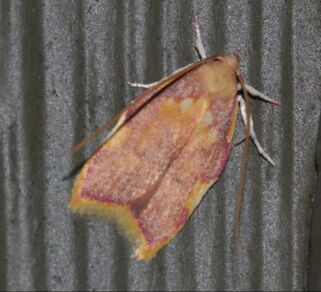|
This micromoth is a variable, colourful moth with long antenna and a distinctive shape. Carcina quercana is native to Europe with a small range in western North America where it is introduced. It was first found in Victoria in 1920 and there are records from Victoria to Port Alberni, the lower mainland and the Seattle area in Washington State. Most references suggest it is a specialist on oaks, and indeed one of the other names for it is the Oak Skeletonizer Moth. In fact however, it appears to use a wide variety of host plants for its caterpillars, including beeches, blackberries, apples, chestnuts and recently in Victoria, it has been found feeding on Snowberry.
The larvae are small green caterpillars found on the underside of leaves, usually protected by white webbing. Another common name is Long-horned Flat-Body and the "flat body" is a characteristic of the family, the Depressariidae (which means flat). It can be tan, pinkish, orange or brown, usually with a small yellow line at the wing tip and a larger yellow spot on the wing and very long antenna, sometimes longer than the body of the moth.
1 Comment
11/11/2020 01:43:50 pm
I saw quite a large number of these being drawn to my porch light this summer as I tried to console my cancelled birding plans with a renewed interest in Lepidopterology. Interesting to hear they're more of a generalist than their name would let on, yet another reminder not to take common names at face value.
Reply
Leave a Reply. |
AuthorsTwo biologists on a beautiful property armed with cameras, smart phones and a marginal knowledge of websites took up the challenge of documenting one species a day on that property. Join along! Posts and photographs by Leah Ramsay and David Fraser (unless otherwise stated); started January 1, 2014. Categories
All
Archives
May 2025
|

 RSS Feed
RSS Feed